Health and Social Care: Implementing Principles and Regulations Report
VerifiedAdded on 2020/02/03
|14
|4474
|200
Report
AI Summary
This report provides a detailed analysis of the principles in health and social care, examining the application of these principles within care home settings. It explores the principles of support, including respecting individuality, providing proper care, and ensuring equal opportunities for service users. The report analyzes the procedures adopted in care homes to protect individuals from harm, including risk assessment and the rights of individuals to take risks. It highlights the importance of person-centered approaches, using case studies to demonstrate their benefits, such as enhancing independence and maintaining dignity. The report also addresses ethical dilemmas faced by care workers, such as balancing patient autonomy with the need for care. Furthermore, it discusses relevant legislation, regulations, and codes of practice, emphasizing the impact of policies like 'Valuing People' and the Care Standards Act 2000. The report evaluates the effectiveness of local policies and procedures, emphasizing the importance of aligning them with national standards. Finally, it examines the positive impacts of implementing policies and legislation on care practices, development needs, and the overall functioning of care settings.
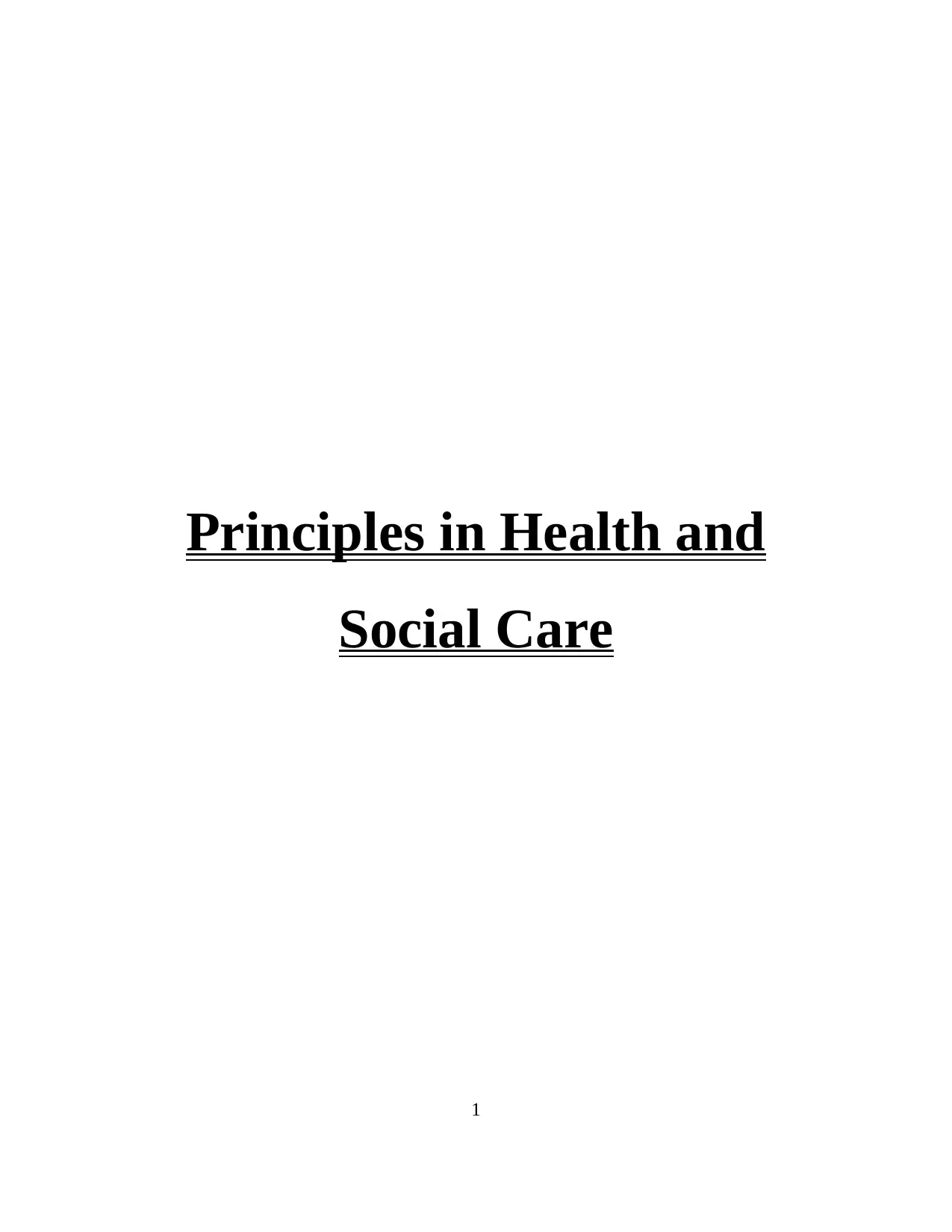
Principles in Health and
Social Care
1
Social Care
1
Secure Best Marks with AI Grader
Need help grading? Try our AI Grader for instant feedback on your assignments.
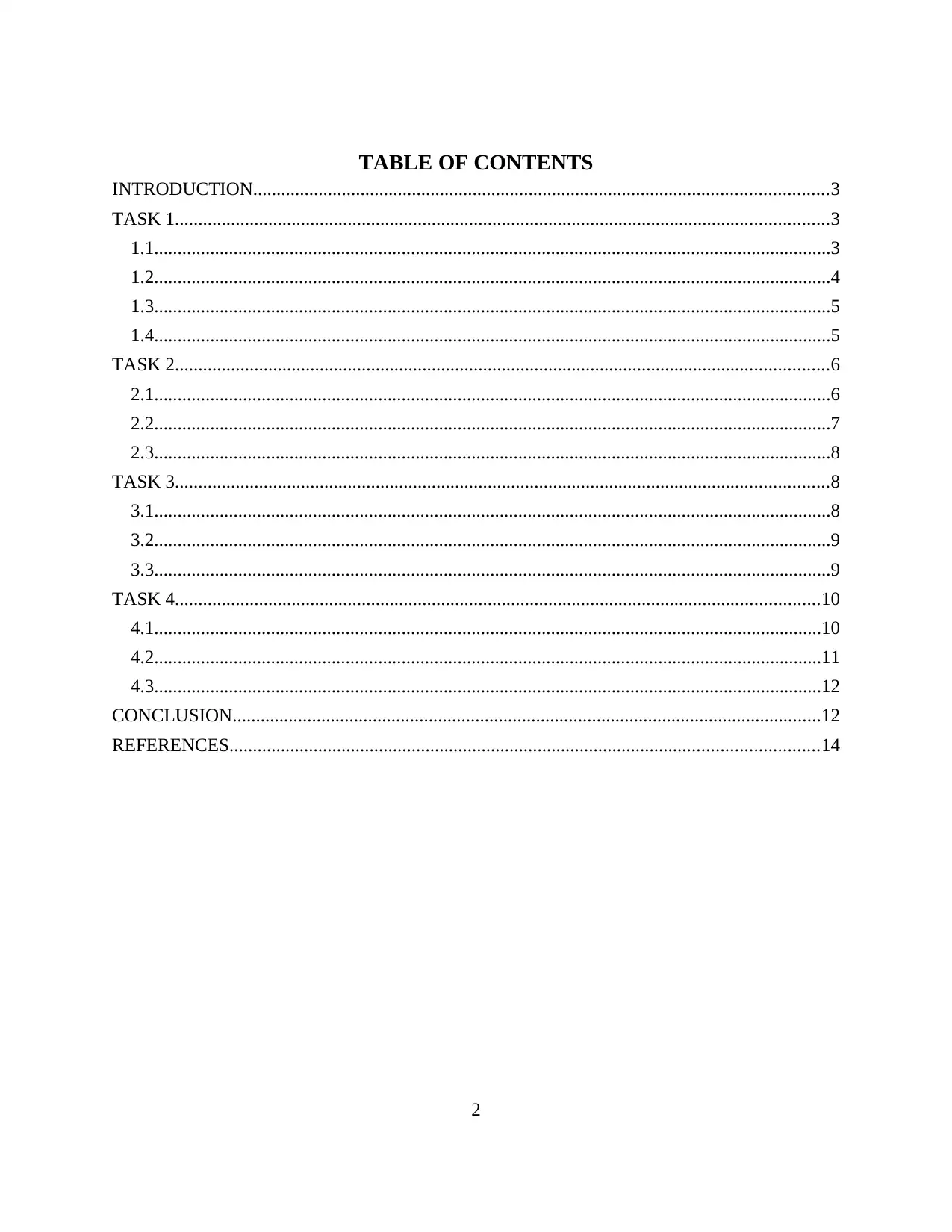
TABLE OF CONTENTS
INTRODUCTION...........................................................................................................................3
TASK 1............................................................................................................................................3
1.1.................................................................................................................................................3
1.2.................................................................................................................................................4
1.3.................................................................................................................................................5
1.4.................................................................................................................................................5
TASK 2............................................................................................................................................6
2.1.................................................................................................................................................6
2.2.................................................................................................................................................7
2.3.................................................................................................................................................8
TASK 3............................................................................................................................................8
3.1.................................................................................................................................................8
3.2.................................................................................................................................................9
3.3.................................................................................................................................................9
TASK 4..........................................................................................................................................10
4.1...............................................................................................................................................10
4.2...............................................................................................................................................11
4.3...............................................................................................................................................12
CONCLUSION..............................................................................................................................12
REFERENCES..............................................................................................................................14
2
INTRODUCTION...........................................................................................................................3
TASK 1............................................................................................................................................3
1.1.................................................................................................................................................3
1.2.................................................................................................................................................4
1.3.................................................................................................................................................5
1.4.................................................................................................................................................5
TASK 2............................................................................................................................................6
2.1.................................................................................................................................................6
2.2.................................................................................................................................................7
2.3.................................................................................................................................................8
TASK 3............................................................................................................................................8
3.1.................................................................................................................................................8
3.2.................................................................................................................................................9
3.3.................................................................................................................................................9
TASK 4..........................................................................................................................................10
4.1...............................................................................................................................................10
4.2...............................................................................................................................................11
4.3...............................................................................................................................................12
CONCLUSION..............................................................................................................................12
REFERENCES..............................................................................................................................14
2
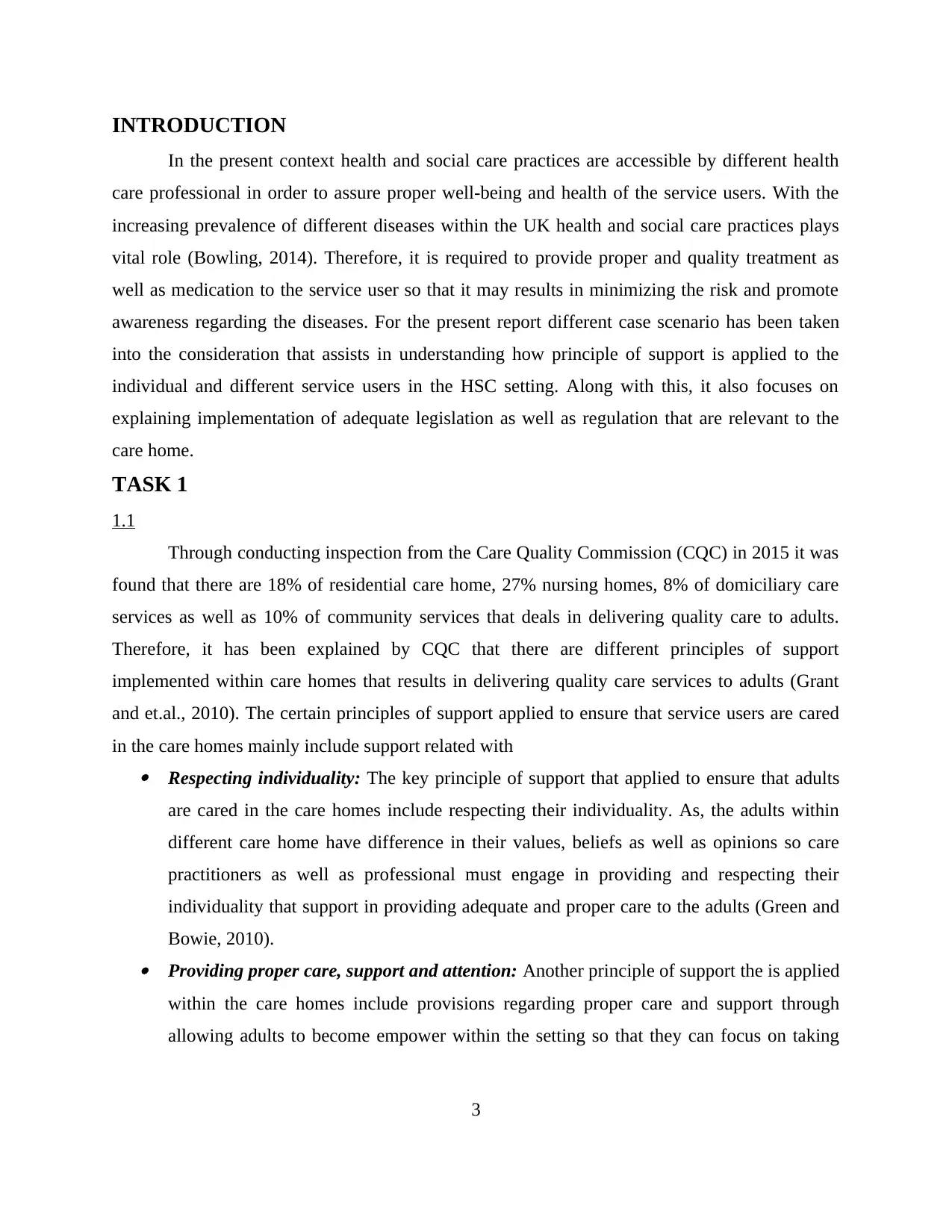
INTRODUCTION
In the present context health and social care practices are accessible by different health
care professional in order to assure proper well-being and health of the service users. With the
increasing prevalence of different diseases within the UK health and social care practices plays
vital role (Bowling, 2014). Therefore, it is required to provide proper and quality treatment as
well as medication to the service user so that it may results in minimizing the risk and promote
awareness regarding the diseases. For the present report different case scenario has been taken
into the consideration that assists in understanding how principle of support is applied to the
individual and different service users in the HSC setting. Along with this, it also focuses on
explaining implementation of adequate legislation as well as regulation that are relevant to the
care home.
TASK 1
1.1
Through conducting inspection from the Care Quality Commission (CQC) in 2015 it was
found that there are 18% of residential care home, 27% nursing homes, 8% of domiciliary care
services as well as 10% of community services that deals in delivering quality care to adults.
Therefore, it has been explained by CQC that there are different principles of support
implemented within care homes that results in delivering quality care services to adults (Grant
and et.al., 2010). The certain principles of support applied to ensure that service users are cared
in the care homes mainly include support related with Respecting individuality: The key principle of support that applied to ensure that adults
are cared in the care homes include respecting their individuality. As, the adults within
different care home have difference in their values, beliefs as well as opinions so care
practitioners as well as professional must engage in providing and respecting their
individuality that support in providing adequate and proper care to the adults (Green and
Bowie, 2010). Providing proper care, support and attention: Another principle of support the is applied
within the care homes include provisions regarding proper care and support through
allowing adults to become empower within the setting so that they can focus on taking
3
In the present context health and social care practices are accessible by different health
care professional in order to assure proper well-being and health of the service users. With the
increasing prevalence of different diseases within the UK health and social care practices plays
vital role (Bowling, 2014). Therefore, it is required to provide proper and quality treatment as
well as medication to the service user so that it may results in minimizing the risk and promote
awareness regarding the diseases. For the present report different case scenario has been taken
into the consideration that assists in understanding how principle of support is applied to the
individual and different service users in the HSC setting. Along with this, it also focuses on
explaining implementation of adequate legislation as well as regulation that are relevant to the
care home.
TASK 1
1.1
Through conducting inspection from the Care Quality Commission (CQC) in 2015 it was
found that there are 18% of residential care home, 27% nursing homes, 8% of domiciliary care
services as well as 10% of community services that deals in delivering quality care to adults.
Therefore, it has been explained by CQC that there are different principles of support
implemented within care homes that results in delivering quality care services to adults (Grant
and et.al., 2010). The certain principles of support applied to ensure that service users are cared
in the care homes mainly include support related with Respecting individuality: The key principle of support that applied to ensure that adults
are cared in the care homes include respecting their individuality. As, the adults within
different care home have difference in their values, beliefs as well as opinions so care
practitioners as well as professional must engage in providing and respecting their
individuality that support in providing adequate and proper care to the adults (Green and
Bowie, 2010). Providing proper care, support and attention: Another principle of support the is applied
within the care homes include provisions regarding proper care and support through
allowing adults to become empower within the setting so that they can focus on taking
3
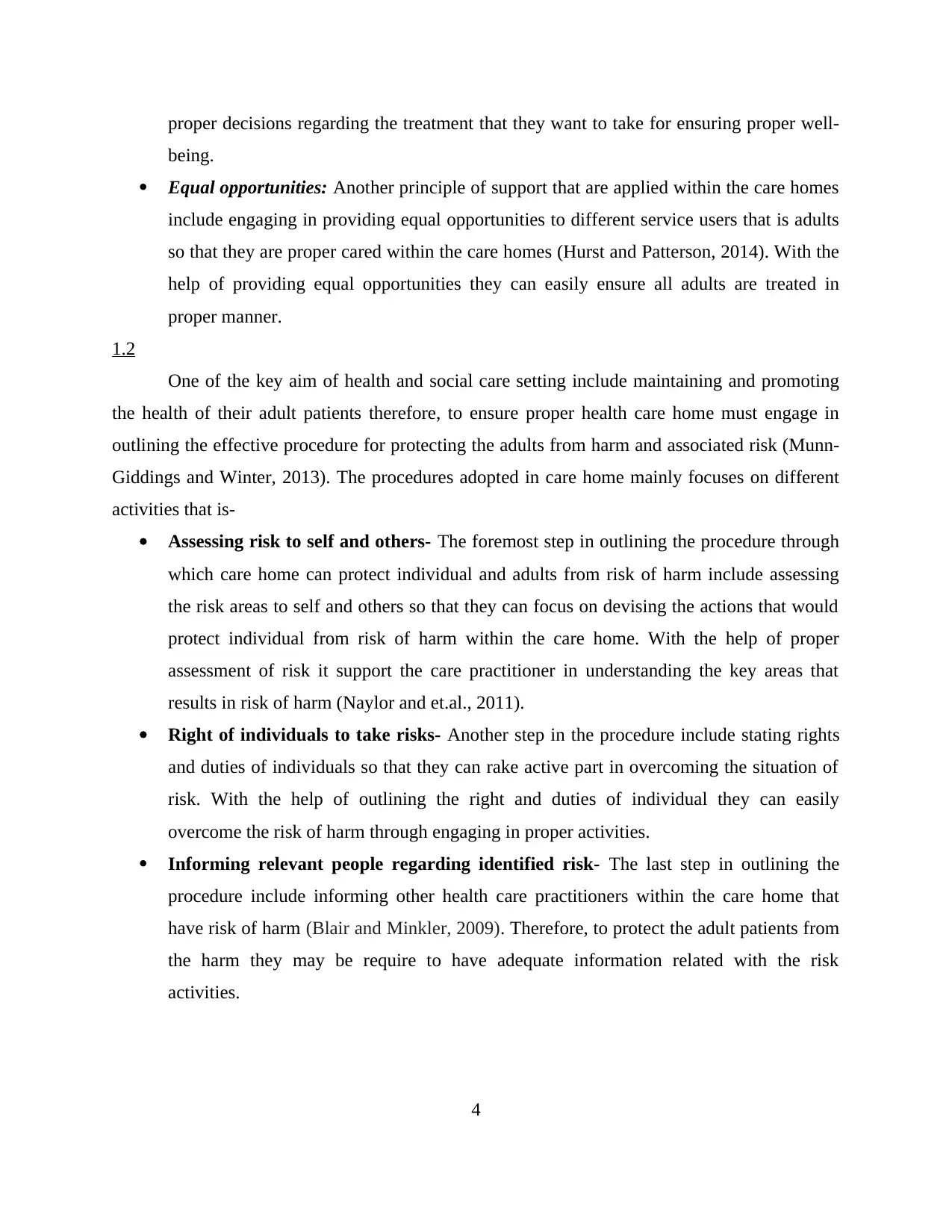
proper decisions regarding the treatment that they want to take for ensuring proper well-
being.
Equal opportunities: Another principle of support that are applied within the care homes
include engaging in providing equal opportunities to different service users that is adults
so that they are proper cared within the care homes (Hurst and Patterson, 2014). With the
help of providing equal opportunities they can easily ensure all adults are treated in
proper manner.
1.2
One of the key aim of health and social care setting include maintaining and promoting
the health of their adult patients therefore, to ensure proper health care home must engage in
outlining the effective procedure for protecting the adults from harm and associated risk (Munn-
Giddings and Winter, 2013). The procedures adopted in care home mainly focuses on different
activities that is-
Assessing risk to self and others- The foremost step in outlining the procedure through
which care home can protect individual and adults from risk of harm include assessing
the risk areas to self and others so that they can focus on devising the actions that would
protect individual from risk of harm within the care home. With the help of proper
assessment of risk it support the care practitioner in understanding the key areas that
results in risk of harm (Naylor and et.al., 2011).
Right of individuals to take risks- Another step in the procedure include stating rights
and duties of individuals so that they can rake active part in overcoming the situation of
risk. With the help of outlining the right and duties of individual they can easily
overcome the risk of harm through engaging in proper activities.
Informing relevant people regarding identified risk- The last step in outlining the
procedure include informing other health care practitioners within the care home that
have risk of harm (Blair and Minkler, 2009). Therefore, to protect the adult patients from
the harm they may be require to have adequate information related with the risk
activities.
4
being.
Equal opportunities: Another principle of support that are applied within the care homes
include engaging in providing equal opportunities to different service users that is adults
so that they are proper cared within the care homes (Hurst and Patterson, 2014). With the
help of providing equal opportunities they can easily ensure all adults are treated in
proper manner.
1.2
One of the key aim of health and social care setting include maintaining and promoting
the health of their adult patients therefore, to ensure proper health care home must engage in
outlining the effective procedure for protecting the adults from harm and associated risk (Munn-
Giddings and Winter, 2013). The procedures adopted in care home mainly focuses on different
activities that is-
Assessing risk to self and others- The foremost step in outlining the procedure through
which care home can protect individual and adults from risk of harm include assessing
the risk areas to self and others so that they can focus on devising the actions that would
protect individual from risk of harm within the care home. With the help of proper
assessment of risk it support the care practitioner in understanding the key areas that
results in risk of harm (Naylor and et.al., 2011).
Right of individuals to take risks- Another step in the procedure include stating rights
and duties of individuals so that they can rake active part in overcoming the situation of
risk. With the help of outlining the right and duties of individual they can easily
overcome the risk of harm through engaging in proper activities.
Informing relevant people regarding identified risk- The last step in outlining the
procedure include informing other health care practitioners within the care home that
have risk of harm (Blair and Minkler, 2009). Therefore, to protect the adult patients from
the harm they may be require to have adequate information related with the risk
activities.
4
Secure Best Marks with AI Grader
Need help grading? Try our AI Grader for instant feedback on your assignments.
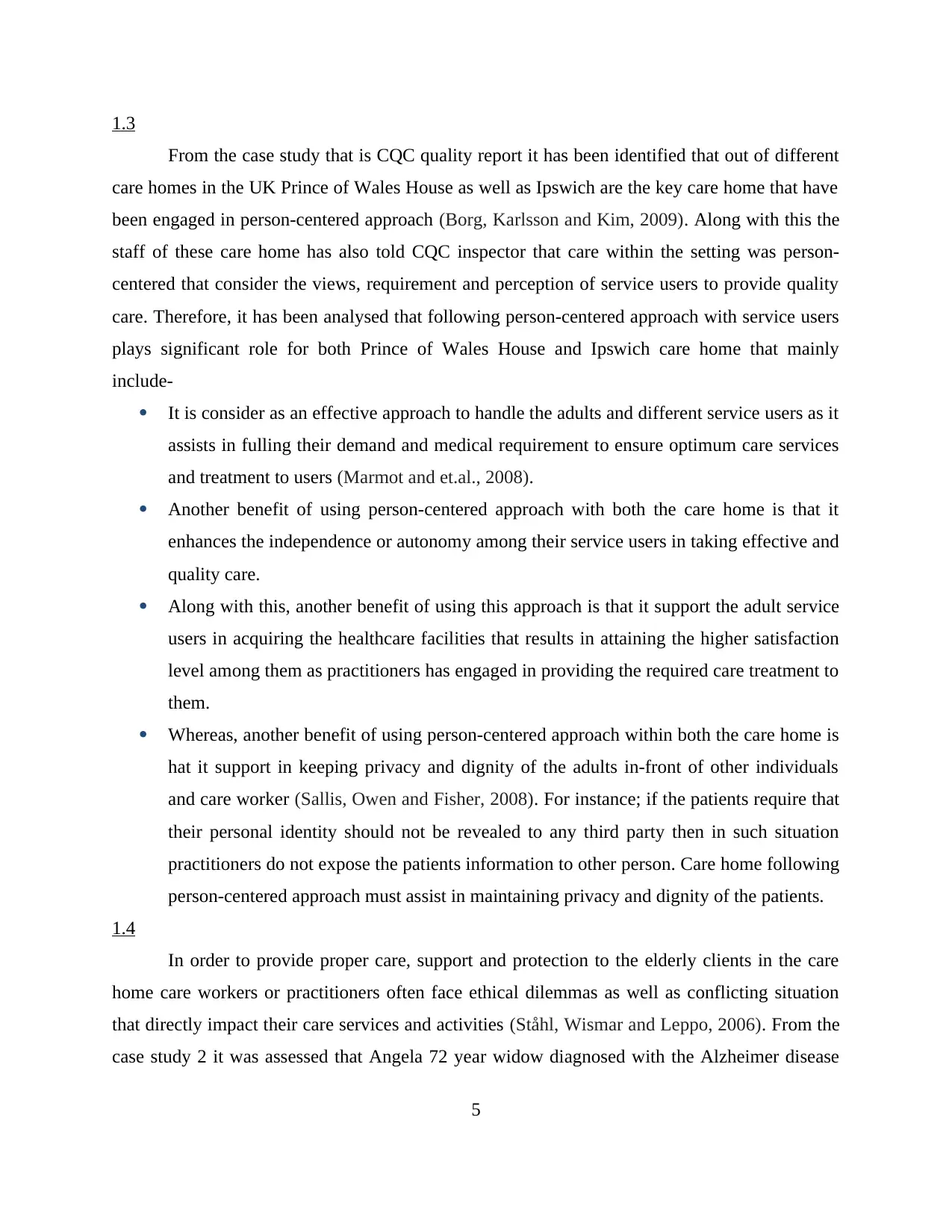
1.3
From the case study that is CQC quality report it has been identified that out of different
care homes in the UK Prince of Wales House as well as Ipswich are the key care home that have
been engaged in person-centered approach (Borg, Karlsson and Kim, 2009). Along with this the
staff of these care home has also told CQC inspector that care within the setting was person-
centered that consider the views, requirement and perception of service users to provide quality
care. Therefore, it has been analysed that following person-centered approach with service users
plays significant role for both Prince of Wales House and Ipswich care home that mainly
include-
It is consider as an effective approach to handle the adults and different service users as it
assists in fulling their demand and medical requirement to ensure optimum care services
and treatment to users (Marmot and et.al., 2008).
Another benefit of using person-centered approach with both the care home is that it
enhances the independence or autonomy among their service users in taking effective and
quality care.
Along with this, another benefit of using this approach is that it support the adult service
users in acquiring the healthcare facilities that results in attaining the higher satisfaction
level among them as practitioners has engaged in providing the required care treatment to
them.
Whereas, another benefit of using person-centered approach within both the care home is
hat it support in keeping privacy and dignity of the adults in-front of other individuals
and care worker (Sallis, Owen and Fisher, 2008). For instance; if the patients require that
their personal identity should not be revealed to any third party then in such situation
practitioners do not expose the patients information to other person. Care home following
person-centered approach must assist in maintaining privacy and dignity of the patients.
1.4
In order to provide proper care, support and protection to the elderly clients in the care
home care workers or practitioners often face ethical dilemmas as well as conflicting situation
that directly impact their care services and activities (Ståhl, Wismar and Leppo, 2006). From the
case study 2 it was assessed that Angela 72 year widow diagnosed with the Alzheimer disease
5
From the case study that is CQC quality report it has been identified that out of different
care homes in the UK Prince of Wales House as well as Ipswich are the key care home that have
been engaged in person-centered approach (Borg, Karlsson and Kim, 2009). Along with this the
staff of these care home has also told CQC inspector that care within the setting was person-
centered that consider the views, requirement and perception of service users to provide quality
care. Therefore, it has been analysed that following person-centered approach with service users
plays significant role for both Prince of Wales House and Ipswich care home that mainly
include-
It is consider as an effective approach to handle the adults and different service users as it
assists in fulling their demand and medical requirement to ensure optimum care services
and treatment to users (Marmot and et.al., 2008).
Another benefit of using person-centered approach with both the care home is that it
enhances the independence or autonomy among their service users in taking effective and
quality care.
Along with this, another benefit of using this approach is that it support the adult service
users in acquiring the healthcare facilities that results in attaining the higher satisfaction
level among them as practitioners has engaged in providing the required care treatment to
them.
Whereas, another benefit of using person-centered approach within both the care home is
hat it support in keeping privacy and dignity of the adults in-front of other individuals
and care worker (Sallis, Owen and Fisher, 2008). For instance; if the patients require that
their personal identity should not be revealed to any third party then in such situation
practitioners do not expose the patients information to other person. Care home following
person-centered approach must assist in maintaining privacy and dignity of the patients.
1.4
In order to provide proper care, support and protection to the elderly clients in the care
home care workers or practitioners often face ethical dilemmas as well as conflicting situation
that directly impact their care services and activities (Ståhl, Wismar and Leppo, 2006). From the
case study 2 it was assessed that Angela 72 year widow diagnosed with the Alzheimer disease
5
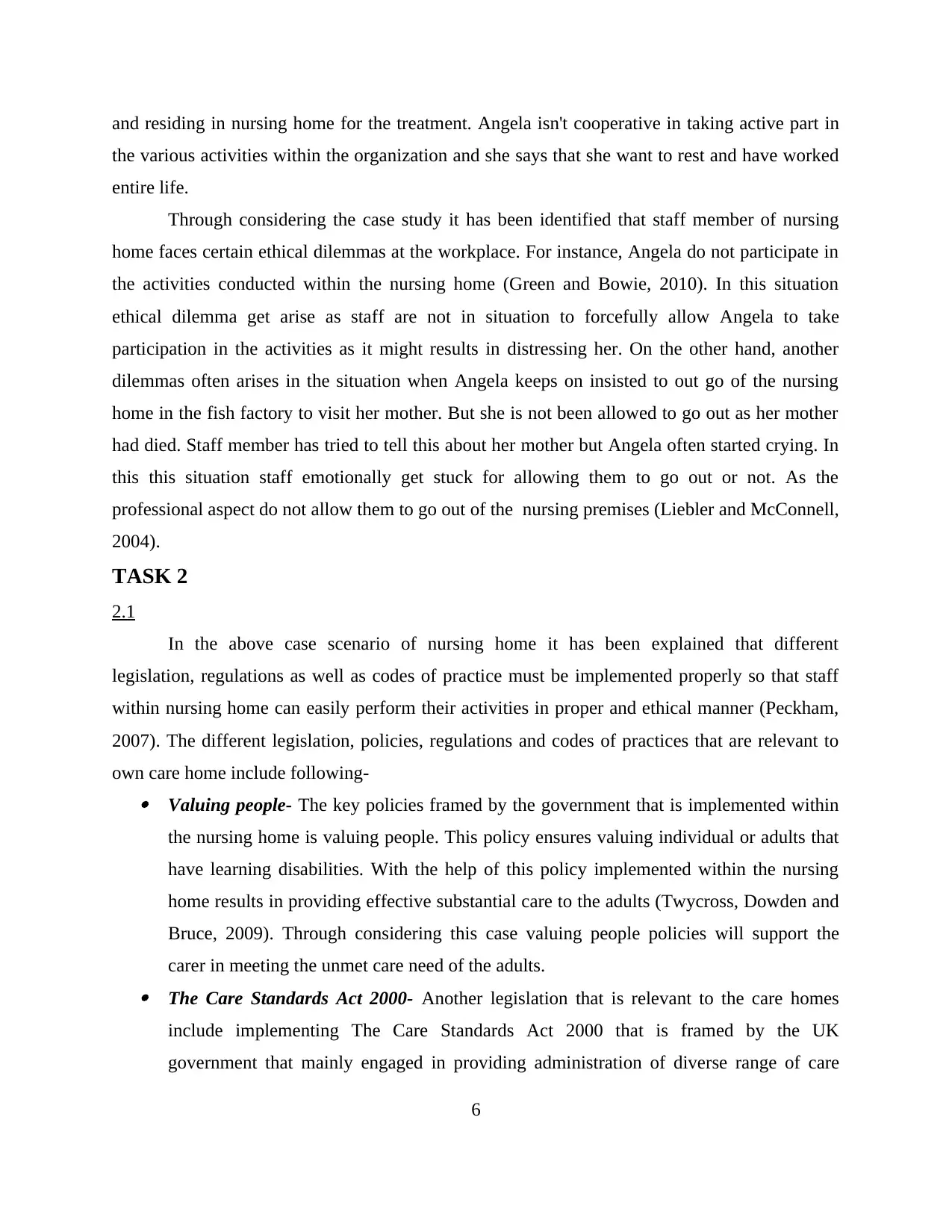
and residing in nursing home for the treatment. Angela isn't cooperative in taking active part in
the various activities within the organization and she says that she want to rest and have worked
entire life.
Through considering the case study it has been identified that staff member of nursing
home faces certain ethical dilemmas at the workplace. For instance, Angela do not participate in
the activities conducted within the nursing home (Green and Bowie, 2010). In this situation
ethical dilemma get arise as staff are not in situation to forcefully allow Angela to take
participation in the activities as it might results in distressing her. On the other hand, another
dilemmas often arises in the situation when Angela keeps on insisted to out go of the nursing
home in the fish factory to visit her mother. But she is not been allowed to go out as her mother
had died. Staff member has tried to tell this about her mother but Angela often started crying. In
this this situation staff emotionally get stuck for allowing them to go out or not. As the
professional aspect do not allow them to go out of the nursing premises (Liebler and McConnell,
2004).
TASK 2
2.1
In the above case scenario of nursing home it has been explained that different
legislation, regulations as well as codes of practice must be implemented properly so that staff
within nursing home can easily perform their activities in proper and ethical manner (Peckham,
2007). The different legislation, policies, regulations and codes of practices that are relevant to
own care home include following- Valuing people- The key policies framed by the government that is implemented within
the nursing home is valuing people. This policy ensures valuing individual or adults that
have learning disabilities. With the help of this policy implemented within the nursing
home results in providing effective substantial care to the adults (Twycross, Dowden and
Bruce, 2009). Through considering this case valuing people policies will support the
carer in meeting the unmet care need of the adults. The Care Standards Act 2000- Another legislation that is relevant to the care homes
include implementing The Care Standards Act 2000 that is framed by the UK
government that mainly engaged in providing administration of diverse range of care
6
the various activities within the organization and she says that she want to rest and have worked
entire life.
Through considering the case study it has been identified that staff member of nursing
home faces certain ethical dilemmas at the workplace. For instance, Angela do not participate in
the activities conducted within the nursing home (Green and Bowie, 2010). In this situation
ethical dilemma get arise as staff are not in situation to forcefully allow Angela to take
participation in the activities as it might results in distressing her. On the other hand, another
dilemmas often arises in the situation when Angela keeps on insisted to out go of the nursing
home in the fish factory to visit her mother. But she is not been allowed to go out as her mother
had died. Staff member has tried to tell this about her mother but Angela often started crying. In
this this situation staff emotionally get stuck for allowing them to go out or not. As the
professional aspect do not allow them to go out of the nursing premises (Liebler and McConnell,
2004).
TASK 2
2.1
In the above case scenario of nursing home it has been explained that different
legislation, regulations as well as codes of practice must be implemented properly so that staff
within nursing home can easily perform their activities in proper and ethical manner (Peckham,
2007). The different legislation, policies, regulations and codes of practices that are relevant to
own care home include following- Valuing people- The key policies framed by the government that is implemented within
the nursing home is valuing people. This policy ensures valuing individual or adults that
have learning disabilities. With the help of this policy implemented within the nursing
home results in providing effective substantial care to the adults (Twycross, Dowden and
Bruce, 2009). Through considering this case valuing people policies will support the
carer in meeting the unmet care need of the adults. The Care Standards Act 2000- Another legislation that is relevant to the care homes
include implementing The Care Standards Act 2000 that is framed by the UK
government that mainly engaged in providing administration of diverse range of care
6
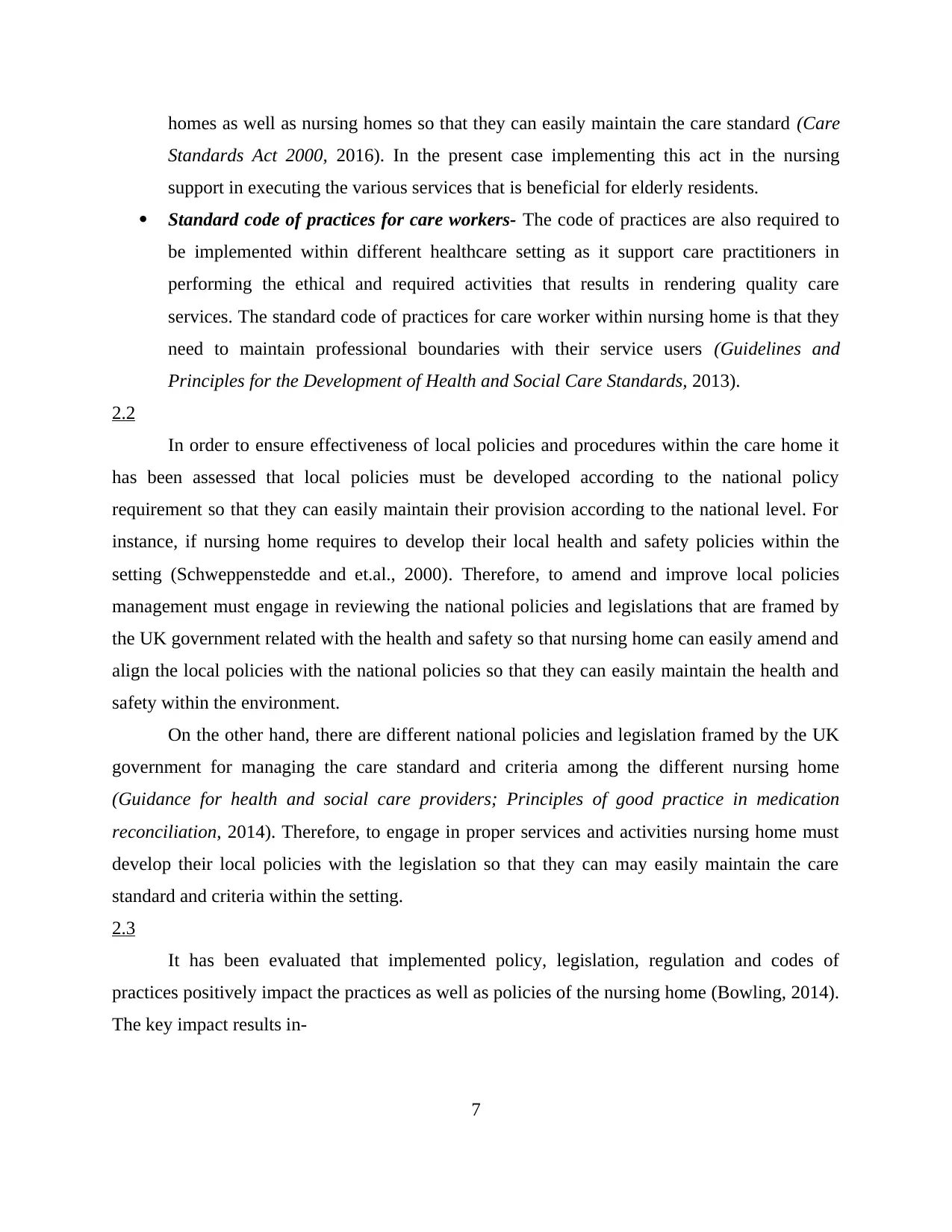
homes as well as nursing homes so that they can easily maintain the care standard (Care
Standards Act 2000, 2016). In the present case implementing this act in the nursing
support in executing the various services that is beneficial for elderly residents.
Standard code of practices for care workers- The code of practices are also required to
be implemented within different healthcare setting as it support care practitioners in
performing the ethical and required activities that results in rendering quality care
services. The standard code of practices for care worker within nursing home is that they
need to maintain professional boundaries with their service users (Guidelines and
Principles for the Development of Health and Social Care Standards, 2013).
2.2
In order to ensure effectiveness of local policies and procedures within the care home it
has been assessed that local policies must be developed according to the national policy
requirement so that they can easily maintain their provision according to the national level. For
instance, if nursing home requires to develop their local health and safety policies within the
setting (Schweppenstedde and et.al., 2000). Therefore, to amend and improve local policies
management must engage in reviewing the national policies and legislations that are framed by
the UK government related with the health and safety so that nursing home can easily amend and
align the local policies with the national policies so that they can easily maintain the health and
safety within the environment.
On the other hand, there are different national policies and legislation framed by the UK
government for managing the care standard and criteria among the different nursing home
(Guidance for health and social care providers; Principles of good practice in medication
reconciliation, 2014). Therefore, to engage in proper services and activities nursing home must
develop their local policies with the legislation so that they can may easily maintain the care
standard and criteria within the setting.
2.3
It has been evaluated that implemented policy, legislation, regulation and codes of
practices positively impact the practices as well as policies of the nursing home (Bowling, 2014).
The key impact results in-
7
Standards Act 2000, 2016). In the present case implementing this act in the nursing
support in executing the various services that is beneficial for elderly residents.
Standard code of practices for care workers- The code of practices are also required to
be implemented within different healthcare setting as it support care practitioners in
performing the ethical and required activities that results in rendering quality care
services. The standard code of practices for care worker within nursing home is that they
need to maintain professional boundaries with their service users (Guidelines and
Principles for the Development of Health and Social Care Standards, 2013).
2.2
In order to ensure effectiveness of local policies and procedures within the care home it
has been assessed that local policies must be developed according to the national policy
requirement so that they can easily maintain their provision according to the national level. For
instance, if nursing home requires to develop their local health and safety policies within the
setting (Schweppenstedde and et.al., 2000). Therefore, to amend and improve local policies
management must engage in reviewing the national policies and legislations that are framed by
the UK government related with the health and safety so that nursing home can easily amend and
align the local policies with the national policies so that they can easily maintain the health and
safety within the environment.
On the other hand, there are different national policies and legislation framed by the UK
government for managing the care standard and criteria among the different nursing home
(Guidance for health and social care providers; Principles of good practice in medication
reconciliation, 2014). Therefore, to engage in proper services and activities nursing home must
develop their local policies with the legislation so that they can may easily maintain the care
standard and criteria within the setting.
2.3
It has been evaluated that implemented policy, legislation, regulation and codes of
practices positively impact the practices as well as policies of the nursing home (Bowling, 2014).
The key impact results in-
7
Paraphrase This Document
Need a fresh take? Get an instant paraphrase of this document with our AI Paraphraser
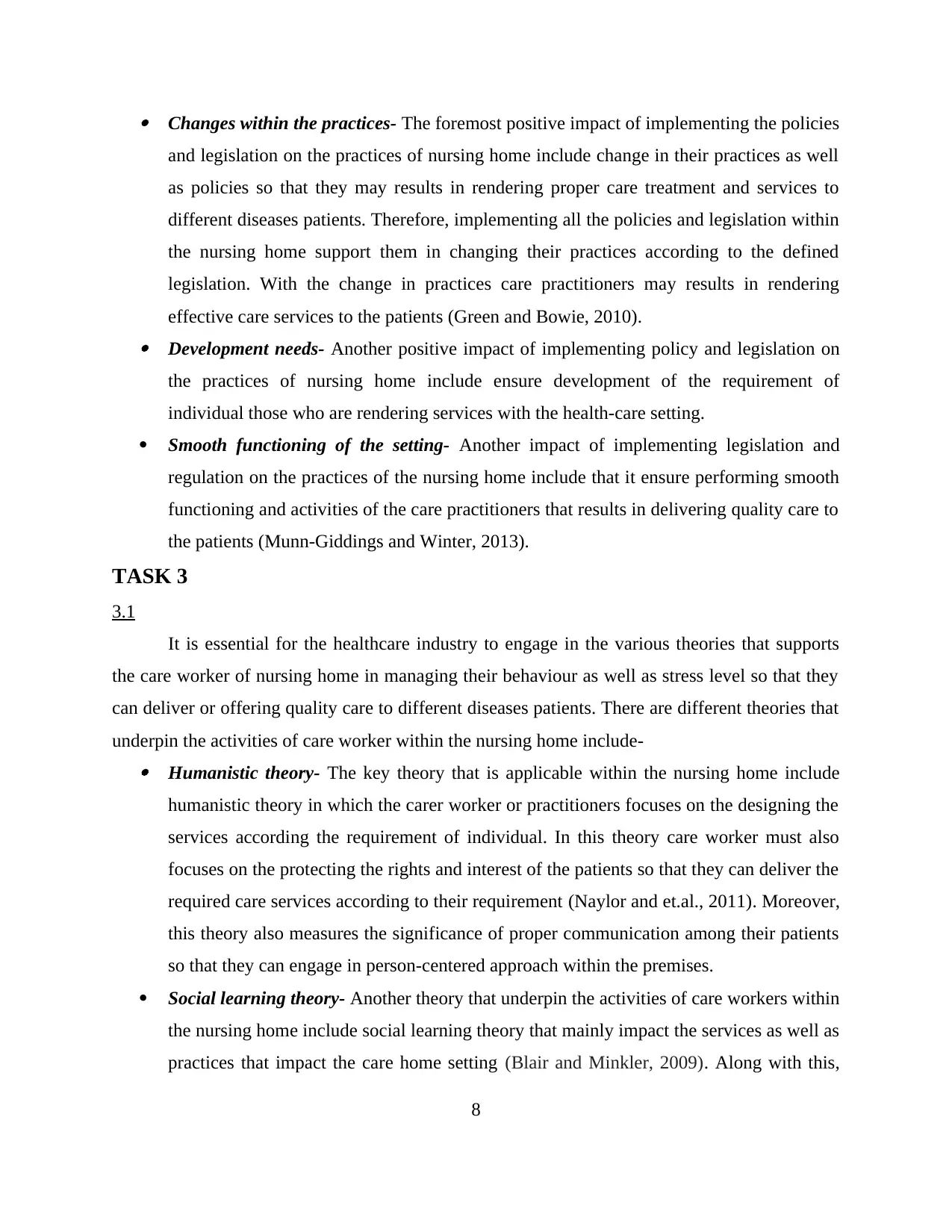
Changes within the practices- The foremost positive impact of implementing the policies
and legislation on the practices of nursing home include change in their practices as well
as policies so that they may results in rendering proper care treatment and services to
different diseases patients. Therefore, implementing all the policies and legislation within
the nursing home support them in changing their practices according to the defined
legislation. With the change in practices care practitioners may results in rendering
effective care services to the patients (Green and Bowie, 2010). Development needs- Another positive impact of implementing policy and legislation on
the practices of nursing home include ensure development of the requirement of
individual those who are rendering services with the health-care setting.
Smooth functioning of the setting- Another impact of implementing legislation and
regulation on the practices of the nursing home include that it ensure performing smooth
functioning and activities of the care practitioners that results in delivering quality care to
the patients (Munn-Giddings and Winter, 2013).
TASK 3
3.1
It is essential for the healthcare industry to engage in the various theories that supports
the care worker of nursing home in managing their behaviour as well as stress level so that they
can deliver or offering quality care to different diseases patients. There are different theories that
underpin the activities of care worker within the nursing home include- Humanistic theory- The key theory that is applicable within the nursing home include
humanistic theory in which the carer worker or practitioners focuses on the designing the
services according the requirement of individual. In this theory care worker must also
focuses on the protecting the rights and interest of the patients so that they can deliver the
required care services according to their requirement (Naylor and et.al., 2011). Moreover,
this theory also measures the significance of proper communication among their patients
so that they can engage in person-centered approach within the premises.
Social learning theory- Another theory that underpin the activities of care workers within
the nursing home include social learning theory that mainly impact the services as well as
practices that impact the care home setting (Blair and Minkler, 2009). Along with this,
8
and legislation on the practices of nursing home include change in their practices as well
as policies so that they may results in rendering proper care treatment and services to
different diseases patients. Therefore, implementing all the policies and legislation within
the nursing home support them in changing their practices according to the defined
legislation. With the change in practices care practitioners may results in rendering
effective care services to the patients (Green and Bowie, 2010). Development needs- Another positive impact of implementing policy and legislation on
the practices of nursing home include ensure development of the requirement of
individual those who are rendering services with the health-care setting.
Smooth functioning of the setting- Another impact of implementing legislation and
regulation on the practices of the nursing home include that it ensure performing smooth
functioning and activities of the care practitioners that results in delivering quality care to
the patients (Munn-Giddings and Winter, 2013).
TASK 3
3.1
It is essential for the healthcare industry to engage in the various theories that supports
the care worker of nursing home in managing their behaviour as well as stress level so that they
can deliver or offering quality care to different diseases patients. There are different theories that
underpin the activities of care worker within the nursing home include- Humanistic theory- The key theory that is applicable within the nursing home include
humanistic theory in which the carer worker or practitioners focuses on the designing the
services according the requirement of individual. In this theory care worker must also
focuses on the protecting the rights and interest of the patients so that they can deliver the
required care services according to their requirement (Naylor and et.al., 2011). Moreover,
this theory also measures the significance of proper communication among their patients
so that they can engage in person-centered approach within the premises.
Social learning theory- Another theory that underpin the activities of care workers within
the nursing home include social learning theory that mainly impact the services as well as
practices that impact the care home setting (Blair and Minkler, 2009). Along with this,
8
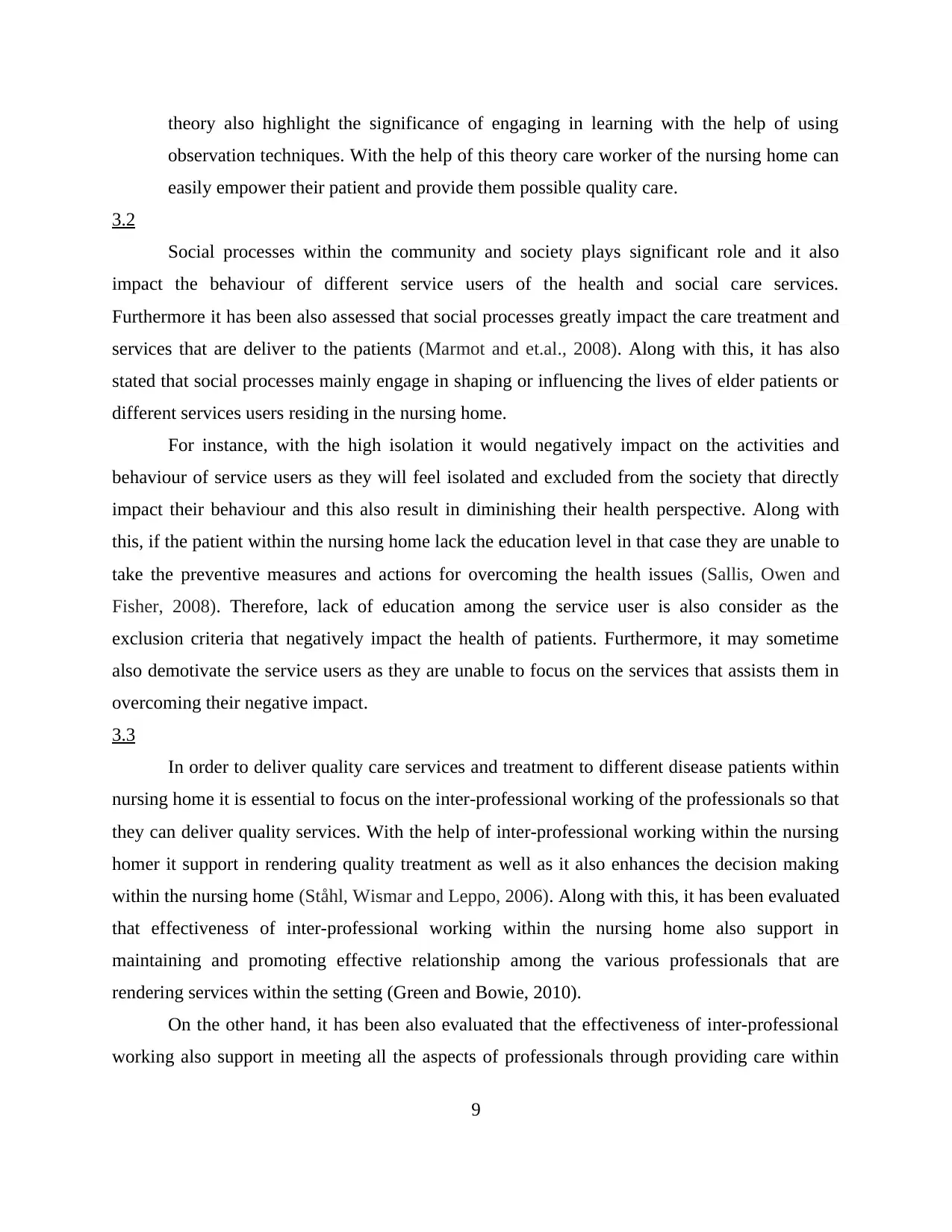
theory also highlight the significance of engaging in learning with the help of using
observation techniques. With the help of this theory care worker of the nursing home can
easily empower their patient and provide them possible quality care.
3.2
Social processes within the community and society plays significant role and it also
impact the behaviour of different service users of the health and social care services.
Furthermore it has been also assessed that social processes greatly impact the care treatment and
services that are deliver to the patients (Marmot and et.al., 2008). Along with this, it has also
stated that social processes mainly engage in shaping or influencing the lives of elder patients or
different services users residing in the nursing home.
For instance, with the high isolation it would negatively impact on the activities and
behaviour of service users as they will feel isolated and excluded from the society that directly
impact their behaviour and this also result in diminishing their health perspective. Along with
this, if the patient within the nursing home lack the education level in that case they are unable to
take the preventive measures and actions for overcoming the health issues (Sallis, Owen and
Fisher, 2008). Therefore, lack of education among the service user is also consider as the
exclusion criteria that negatively impact the health of patients. Furthermore, it may sometime
also demotivate the service users as they are unable to focus on the services that assists them in
overcoming their negative impact.
3.3
In order to deliver quality care services and treatment to different disease patients within
nursing home it is essential to focus on the inter-professional working of the professionals so that
they can deliver quality services. With the help of inter-professional working within the nursing
homer it support in rendering quality treatment as well as it also enhances the decision making
within the nursing home (Ståhl, Wismar and Leppo, 2006). Along with this, it has been evaluated
that effectiveness of inter-professional working within the nursing home also support in
maintaining and promoting effective relationship among the various professionals that are
rendering services within the setting (Green and Bowie, 2010).
On the other hand, it has been also evaluated that the effectiveness of inter-professional
working also support in meeting all the aspects of professionals through providing care within
9
observation techniques. With the help of this theory care worker of the nursing home can
easily empower their patient and provide them possible quality care.
3.2
Social processes within the community and society plays significant role and it also
impact the behaviour of different service users of the health and social care services.
Furthermore it has been also assessed that social processes greatly impact the care treatment and
services that are deliver to the patients (Marmot and et.al., 2008). Along with this, it has also
stated that social processes mainly engage in shaping or influencing the lives of elder patients or
different services users residing in the nursing home.
For instance, with the high isolation it would negatively impact on the activities and
behaviour of service users as they will feel isolated and excluded from the society that directly
impact their behaviour and this also result in diminishing their health perspective. Along with
this, if the patient within the nursing home lack the education level in that case they are unable to
take the preventive measures and actions for overcoming the health issues (Sallis, Owen and
Fisher, 2008). Therefore, lack of education among the service user is also consider as the
exclusion criteria that negatively impact the health of patients. Furthermore, it may sometime
also demotivate the service users as they are unable to focus on the services that assists them in
overcoming their negative impact.
3.3
In order to deliver quality care services and treatment to different disease patients within
nursing home it is essential to focus on the inter-professional working of the professionals so that
they can deliver quality services. With the help of inter-professional working within the nursing
homer it support in rendering quality treatment as well as it also enhances the decision making
within the nursing home (Ståhl, Wismar and Leppo, 2006). Along with this, it has been evaluated
that effectiveness of inter-professional working within the nursing home also support in
maintaining and promoting effective relationship among the various professionals that are
rendering services within the setting (Green and Bowie, 2010).
On the other hand, it has been also evaluated that the effectiveness of inter-professional
working also support in meeting all the aspects of professionals through providing care within
9
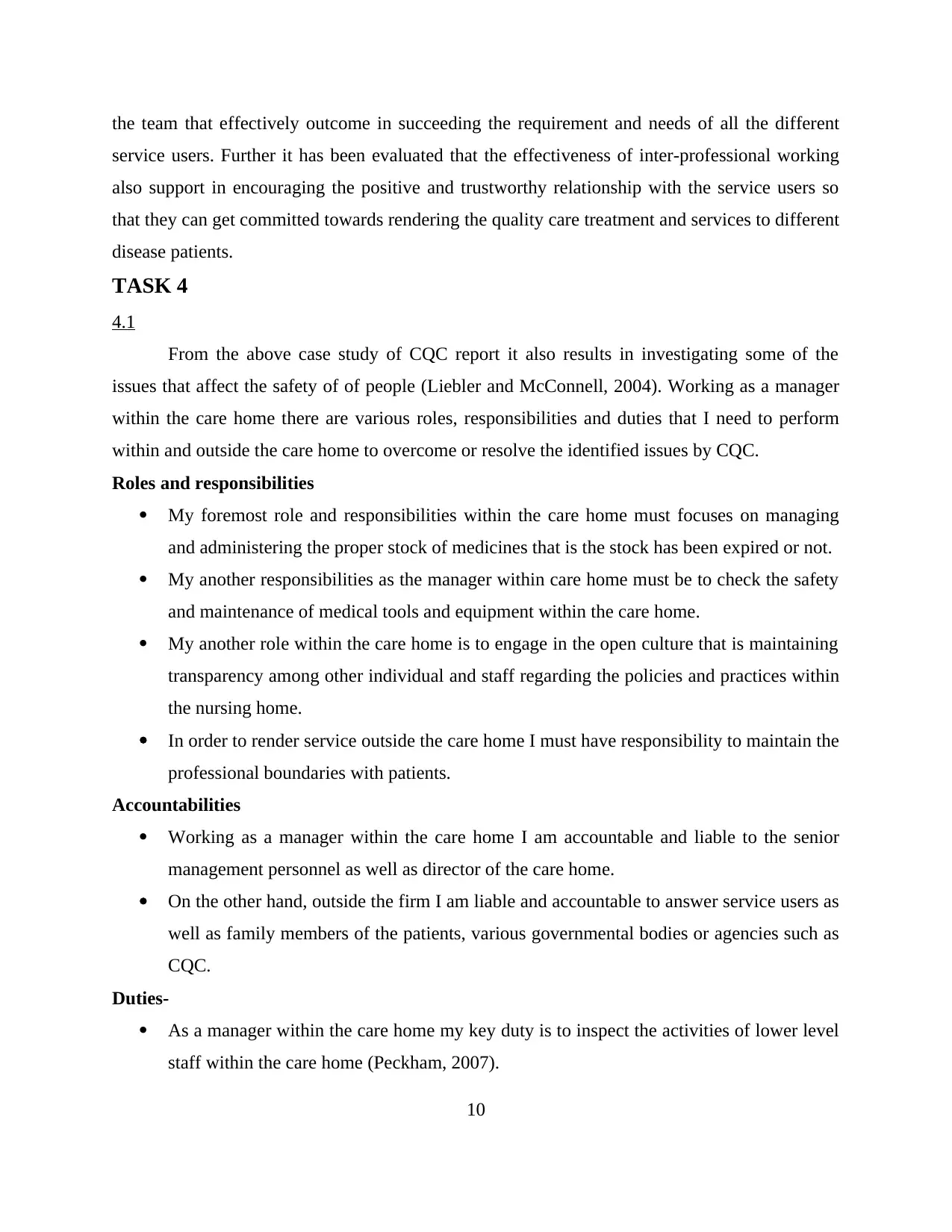
the team that effectively outcome in succeeding the requirement and needs of all the different
service users. Further it has been evaluated that the effectiveness of inter-professional working
also support in encouraging the positive and trustworthy relationship with the service users so
that they can get committed towards rendering the quality care treatment and services to different
disease patients.
TASK 4
4.1
From the above case study of CQC report it also results in investigating some of the
issues that affect the safety of of people (Liebler and McConnell, 2004). Working as a manager
within the care home there are various roles, responsibilities and duties that I need to perform
within and outside the care home to overcome or resolve the identified issues by CQC.
Roles and responsibilities
My foremost role and responsibilities within the care home must focuses on managing
and administering the proper stock of medicines that is the stock has been expired or not.
My another responsibilities as the manager within care home must be to check the safety
and maintenance of medical tools and equipment within the care home.
My another role within the care home is to engage in the open culture that is maintaining
transparency among other individual and staff regarding the policies and practices within
the nursing home.
In order to render service outside the care home I must have responsibility to maintain the
professional boundaries with patients.
Accountabilities
Working as a manager within the care home I am accountable and liable to the senior
management personnel as well as director of the care home.
On the other hand, outside the firm I am liable and accountable to answer service users as
well as family members of the patients, various governmental bodies or agencies such as
CQC.
Duties-
As a manager within the care home my key duty is to inspect the activities of lower level
staff within the care home (Peckham, 2007).
10
service users. Further it has been evaluated that the effectiveness of inter-professional working
also support in encouraging the positive and trustworthy relationship with the service users so
that they can get committed towards rendering the quality care treatment and services to different
disease patients.
TASK 4
4.1
From the above case study of CQC report it also results in investigating some of the
issues that affect the safety of of people (Liebler and McConnell, 2004). Working as a manager
within the care home there are various roles, responsibilities and duties that I need to perform
within and outside the care home to overcome or resolve the identified issues by CQC.
Roles and responsibilities
My foremost role and responsibilities within the care home must focuses on managing
and administering the proper stock of medicines that is the stock has been expired or not.
My another responsibilities as the manager within care home must be to check the safety
and maintenance of medical tools and equipment within the care home.
My another role within the care home is to engage in the open culture that is maintaining
transparency among other individual and staff regarding the policies and practices within
the nursing home.
In order to render service outside the care home I must have responsibility to maintain the
professional boundaries with patients.
Accountabilities
Working as a manager within the care home I am accountable and liable to the senior
management personnel as well as director of the care home.
On the other hand, outside the firm I am liable and accountable to answer service users as
well as family members of the patients, various governmental bodies or agencies such as
CQC.
Duties-
As a manager within the care home my key duty is to inspect the activities of lower level
staff within the care home (Peckham, 2007).
10
Secure Best Marks with AI Grader
Need help grading? Try our AI Grader for instant feedback on your assignments.
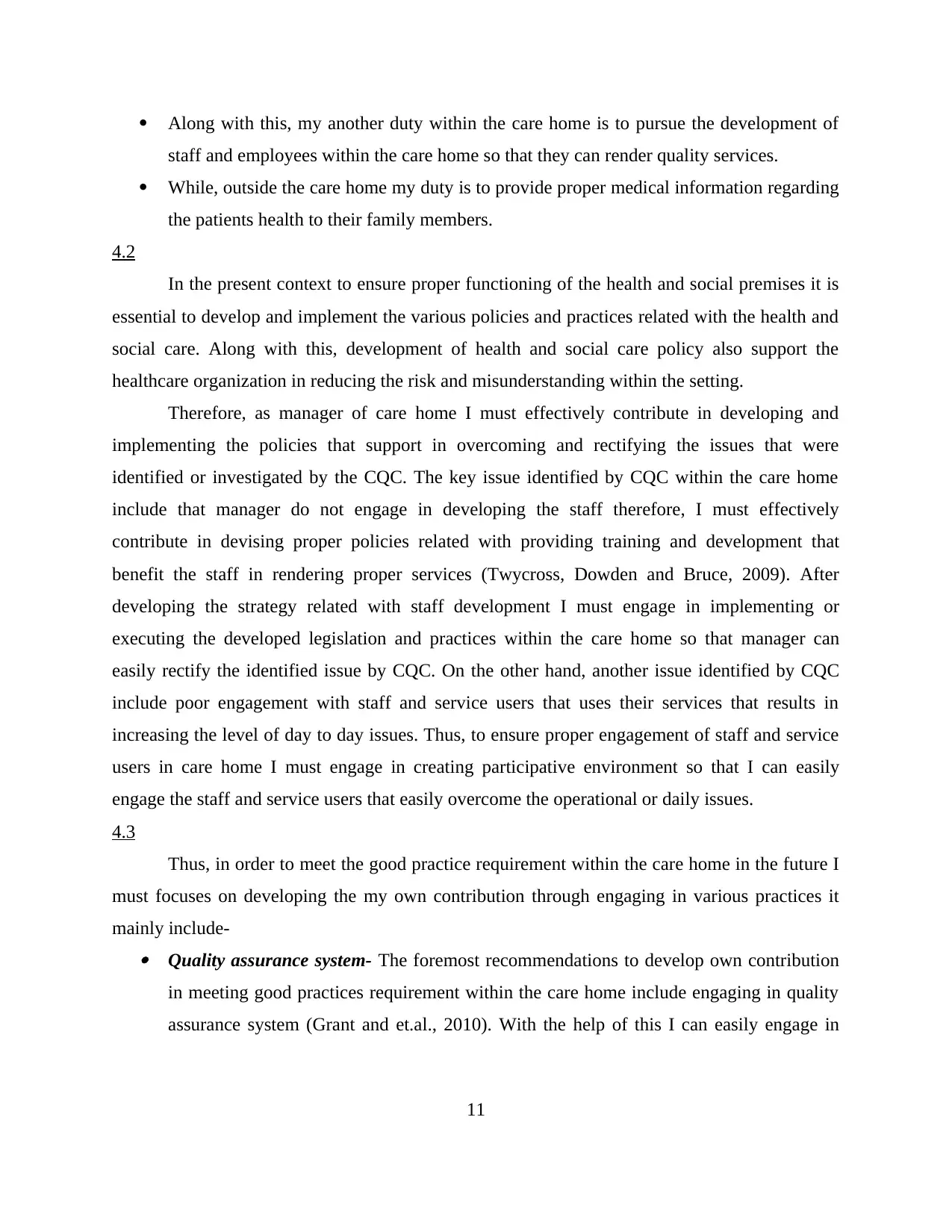
Along with this, my another duty within the care home is to pursue the development of
staff and employees within the care home so that they can render quality services.
While, outside the care home my duty is to provide proper medical information regarding
the patients health to their family members.
4.2
In the present context to ensure proper functioning of the health and social premises it is
essential to develop and implement the various policies and practices related with the health and
social care. Along with this, development of health and social care policy also support the
healthcare organization in reducing the risk and misunderstanding within the setting.
Therefore, as manager of care home I must effectively contribute in developing and
implementing the policies that support in overcoming and rectifying the issues that were
identified or investigated by the CQC. The key issue identified by CQC within the care home
include that manager do not engage in developing the staff therefore, I must effectively
contribute in devising proper policies related with providing training and development that
benefit the staff in rendering proper services (Twycross, Dowden and Bruce, 2009). After
developing the strategy related with staff development I must engage in implementing or
executing the developed legislation and practices within the care home so that manager can
easily rectify the identified issue by CQC. On the other hand, another issue identified by CQC
include poor engagement with staff and service users that uses their services that results in
increasing the level of day to day issues. Thus, to ensure proper engagement of staff and service
users in care home I must engage in creating participative environment so that I can easily
engage the staff and service users that easily overcome the operational or daily issues.
4.3
Thus, in order to meet the good practice requirement within the care home in the future I
must focuses on developing the my own contribution through engaging in various practices it
mainly include- Quality assurance system- The foremost recommendations to develop own contribution
in meeting good practices requirement within the care home include engaging in quality
assurance system (Grant and et.al., 2010). With the help of this I can easily engage in
11
staff and employees within the care home so that they can render quality services.
While, outside the care home my duty is to provide proper medical information regarding
the patients health to their family members.
4.2
In the present context to ensure proper functioning of the health and social premises it is
essential to develop and implement the various policies and practices related with the health and
social care. Along with this, development of health and social care policy also support the
healthcare organization in reducing the risk and misunderstanding within the setting.
Therefore, as manager of care home I must effectively contribute in developing and
implementing the policies that support in overcoming and rectifying the issues that were
identified or investigated by the CQC. The key issue identified by CQC within the care home
include that manager do not engage in developing the staff therefore, I must effectively
contribute in devising proper policies related with providing training and development that
benefit the staff in rendering proper services (Twycross, Dowden and Bruce, 2009). After
developing the strategy related with staff development I must engage in implementing or
executing the developed legislation and practices within the care home so that manager can
easily rectify the identified issue by CQC. On the other hand, another issue identified by CQC
include poor engagement with staff and service users that uses their services that results in
increasing the level of day to day issues. Thus, to ensure proper engagement of staff and service
users in care home I must engage in creating participative environment so that I can easily
engage the staff and service users that easily overcome the operational or daily issues.
4.3
Thus, in order to meet the good practice requirement within the care home in the future I
must focuses on developing the my own contribution through engaging in various practices it
mainly include- Quality assurance system- The foremost recommendations to develop own contribution
in meeting good practices requirement within the care home include engaging in quality
assurance system (Grant and et.al., 2010). With the help of this I can easily engage in
11
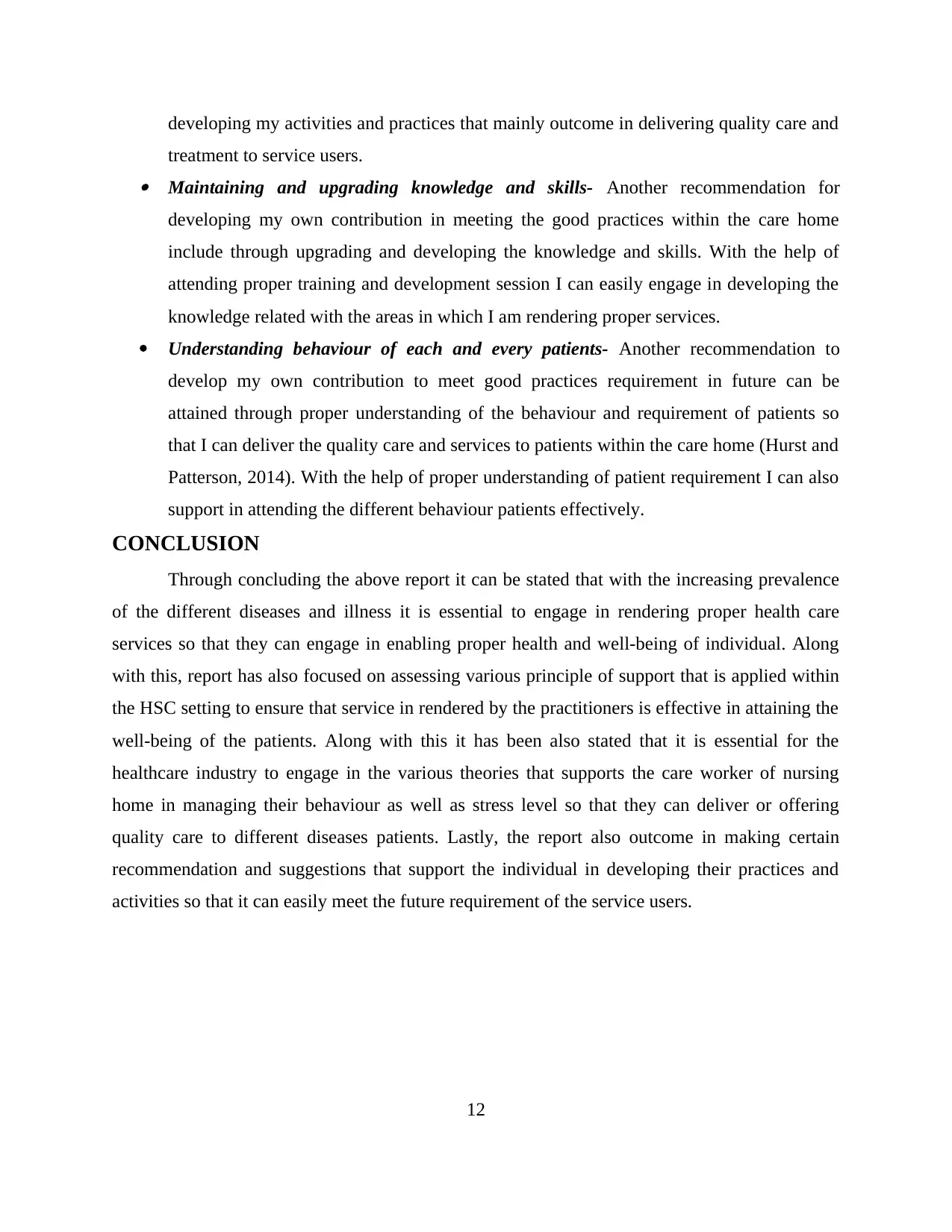
developing my activities and practices that mainly outcome in delivering quality care and
treatment to service users. Maintaining and upgrading knowledge and skills- Another recommendation for
developing my own contribution in meeting the good practices within the care home
include through upgrading and developing the knowledge and skills. With the help of
attending proper training and development session I can easily engage in developing the
knowledge related with the areas in which I am rendering proper services.
Understanding behaviour of each and every patients- Another recommendation to
develop my own contribution to meet good practices requirement in future can be
attained through proper understanding of the behaviour and requirement of patients so
that I can deliver the quality care and services to patients within the care home (Hurst and
Patterson, 2014). With the help of proper understanding of patient requirement I can also
support in attending the different behaviour patients effectively.
CONCLUSION
Through concluding the above report it can be stated that with the increasing prevalence
of the different diseases and illness it is essential to engage in rendering proper health care
services so that they can engage in enabling proper health and well-being of individual. Along
with this, report has also focused on assessing various principle of support that is applied within
the HSC setting to ensure that service in rendered by the practitioners is effective in attaining the
well-being of the patients. Along with this it has been also stated that it is essential for the
healthcare industry to engage in the various theories that supports the care worker of nursing
home in managing their behaviour as well as stress level so that they can deliver or offering
quality care to different diseases patients. Lastly, the report also outcome in making certain
recommendation and suggestions that support the individual in developing their practices and
activities so that it can easily meet the future requirement of the service users.
12
treatment to service users. Maintaining and upgrading knowledge and skills- Another recommendation for
developing my own contribution in meeting the good practices within the care home
include through upgrading and developing the knowledge and skills. With the help of
attending proper training and development session I can easily engage in developing the
knowledge related with the areas in which I am rendering proper services.
Understanding behaviour of each and every patients- Another recommendation to
develop my own contribution to meet good practices requirement in future can be
attained through proper understanding of the behaviour and requirement of patients so
that I can deliver the quality care and services to patients within the care home (Hurst and
Patterson, 2014). With the help of proper understanding of patient requirement I can also
support in attending the different behaviour patients effectively.
CONCLUSION
Through concluding the above report it can be stated that with the increasing prevalence
of the different diseases and illness it is essential to engage in rendering proper health care
services so that they can engage in enabling proper health and well-being of individual. Along
with this, report has also focused on assessing various principle of support that is applied within
the HSC setting to ensure that service in rendered by the practitioners is effective in attaining the
well-being of the patients. Along with this it has been also stated that it is essential for the
healthcare industry to engage in the various theories that supports the care worker of nursing
home in managing their behaviour as well as stress level so that they can deliver or offering
quality care to different diseases patients. Lastly, the report also outcome in making certain
recommendation and suggestions that support the individual in developing their practices and
activities so that it can easily meet the future requirement of the service users.
12
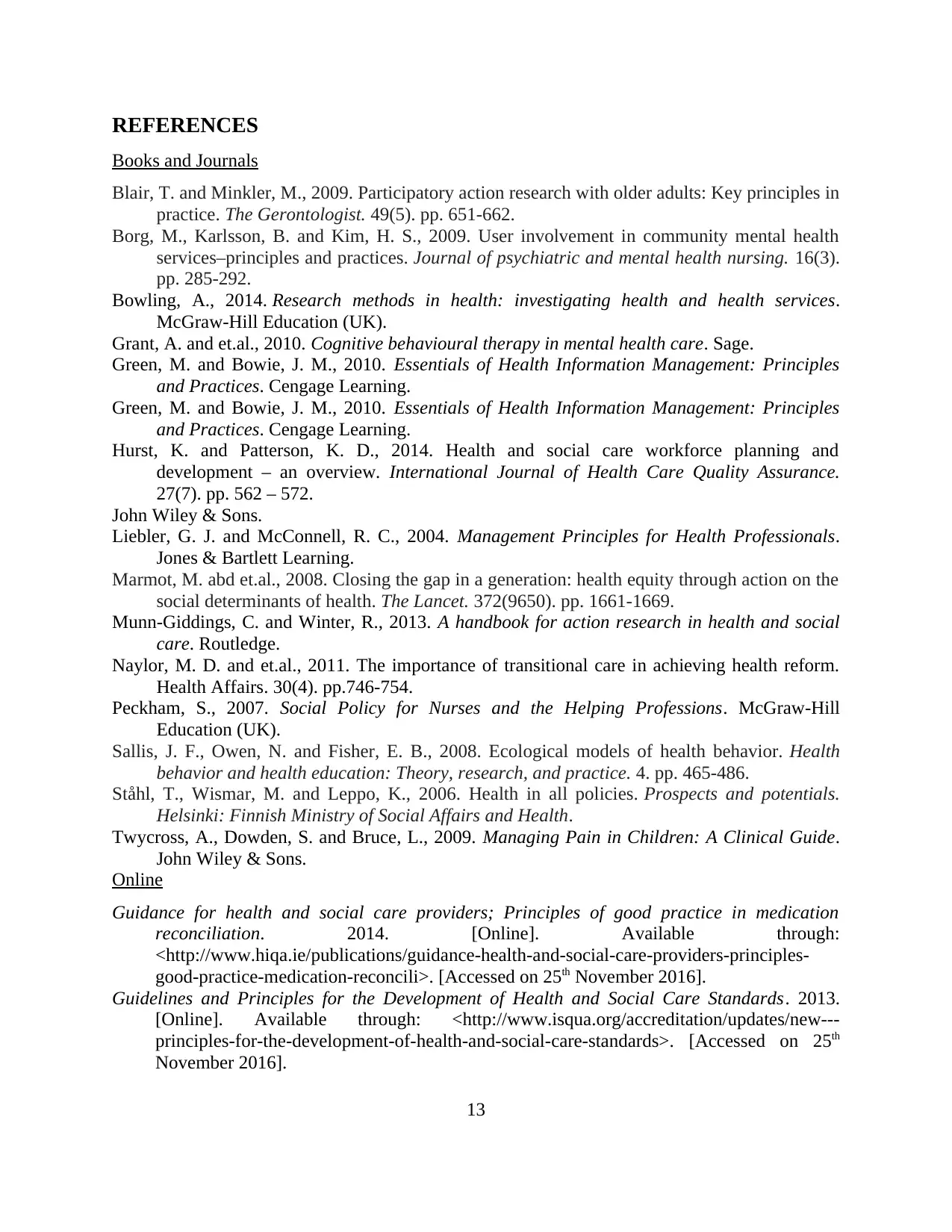
REFERENCES
Books and Journals
Blair, T. and Minkler, M., 2009. Participatory action research with older adults: Key principles in
practice. The Gerontologist. 49(5). pp. 651-662.
Borg, M., Karlsson, B. and Kim, H. S., 2009. User involvement in community mental health
services–principles and practices. Journal of psychiatric and mental health nursing. 16(3).
pp. 285-292.
Bowling, A., 2014. Research methods in health: investigating health and health services.
McGraw-Hill Education (UK).
Grant, A. and et.al., 2010. Cognitive behavioural therapy in mental health care. Sage.
Green, M. and Bowie, J. M., 2010. Essentials of Health Information Management: Principles
and Practices. Cengage Learning.
Green, M. and Bowie, J. M., 2010. Essentials of Health Information Management: Principles
and Practices. Cengage Learning.
Hurst, K. and Patterson, K. D., 2014. Health and social care workforce planning and
development – an overview. International Journal of Health Care Quality Assurance.
27(7). pp. 562 – 572.
John Wiley & Sons.
Liebler, G. J. and McConnell, R. C., 2004. Management Principles for Health Professionals.
Jones & Bartlett Learning.
Marmot, M. abd et.al., 2008. Closing the gap in a generation: health equity through action on the
social determinants of health. The Lancet. 372(9650). pp. 1661-1669.
Munn-Giddings, C. and Winter, R., 2013. A handbook for action research in health and social
care. Routledge.
Naylor, M. D. and et.al., 2011. The importance of transitional care in achieving health reform.
Health Affairs. 30(4). pp.746-754.
Peckham, S., 2007. Social Policy for Nurses and the Helping Professions. McGraw-Hill
Education (UK).
Sallis, J. F., Owen, N. and Fisher, E. B., 2008. Ecological models of health behavior. Health
behavior and health education: Theory, research, and practice. 4. pp. 465-486.
Ståhl, T., Wismar, M. and Leppo, K., 2006. Health in all policies. Prospects and potentials.
Helsinki: Finnish Ministry of Social Affairs and Health.
Twycross, A., Dowden, S. and Bruce, L., 2009. Managing Pain in Children: A Clinical Guide.
John Wiley & Sons.
Online
Guidance for health and social care providers; Principles of good practice in medication
reconciliation. 2014. [Online]. Available through:
<http://www.hiqa.ie/publications/guidance-health-and-social-care-providers-principles-
good-practice-medication-reconcili>. [Accessed on 25th November 2016].
Guidelines and Principles for the Development of Health and Social Care Standards. 2013.
[Online]. Available through: <http://www.isqua.org/accreditation/updates/new---
principles-for-the-development-of-health-and-social-care-standards>. [Accessed on 25th
November 2016].
13
Books and Journals
Blair, T. and Minkler, M., 2009. Participatory action research with older adults: Key principles in
practice. The Gerontologist. 49(5). pp. 651-662.
Borg, M., Karlsson, B. and Kim, H. S., 2009. User involvement in community mental health
services–principles and practices. Journal of psychiatric and mental health nursing. 16(3).
pp. 285-292.
Bowling, A., 2014. Research methods in health: investigating health and health services.
McGraw-Hill Education (UK).
Grant, A. and et.al., 2010. Cognitive behavioural therapy in mental health care. Sage.
Green, M. and Bowie, J. M., 2010. Essentials of Health Information Management: Principles
and Practices. Cengage Learning.
Green, M. and Bowie, J. M., 2010. Essentials of Health Information Management: Principles
and Practices. Cengage Learning.
Hurst, K. and Patterson, K. D., 2014. Health and social care workforce planning and
development – an overview. International Journal of Health Care Quality Assurance.
27(7). pp. 562 – 572.
John Wiley & Sons.
Liebler, G. J. and McConnell, R. C., 2004. Management Principles for Health Professionals.
Jones & Bartlett Learning.
Marmot, M. abd et.al., 2008. Closing the gap in a generation: health equity through action on the
social determinants of health. The Lancet. 372(9650). pp. 1661-1669.
Munn-Giddings, C. and Winter, R., 2013. A handbook for action research in health and social
care. Routledge.
Naylor, M. D. and et.al., 2011. The importance of transitional care in achieving health reform.
Health Affairs. 30(4). pp.746-754.
Peckham, S., 2007. Social Policy for Nurses and the Helping Professions. McGraw-Hill
Education (UK).
Sallis, J. F., Owen, N. and Fisher, E. B., 2008. Ecological models of health behavior. Health
behavior and health education: Theory, research, and practice. 4. pp. 465-486.
Ståhl, T., Wismar, M. and Leppo, K., 2006. Health in all policies. Prospects and potentials.
Helsinki: Finnish Ministry of Social Affairs and Health.
Twycross, A., Dowden, S. and Bruce, L., 2009. Managing Pain in Children: A Clinical Guide.
John Wiley & Sons.
Online
Guidance for health and social care providers; Principles of good practice in medication
reconciliation. 2014. [Online]. Available through:
<http://www.hiqa.ie/publications/guidance-health-and-social-care-providers-principles-
good-practice-medication-reconcili>. [Accessed on 25th November 2016].
Guidelines and Principles for the Development of Health and Social Care Standards. 2013.
[Online]. Available through: <http://www.isqua.org/accreditation/updates/new---
principles-for-the-development-of-health-and-social-care-standards>. [Accessed on 25th
November 2016].
13
Paraphrase This Document
Need a fresh take? Get an instant paraphrase of this document with our AI Paraphraser
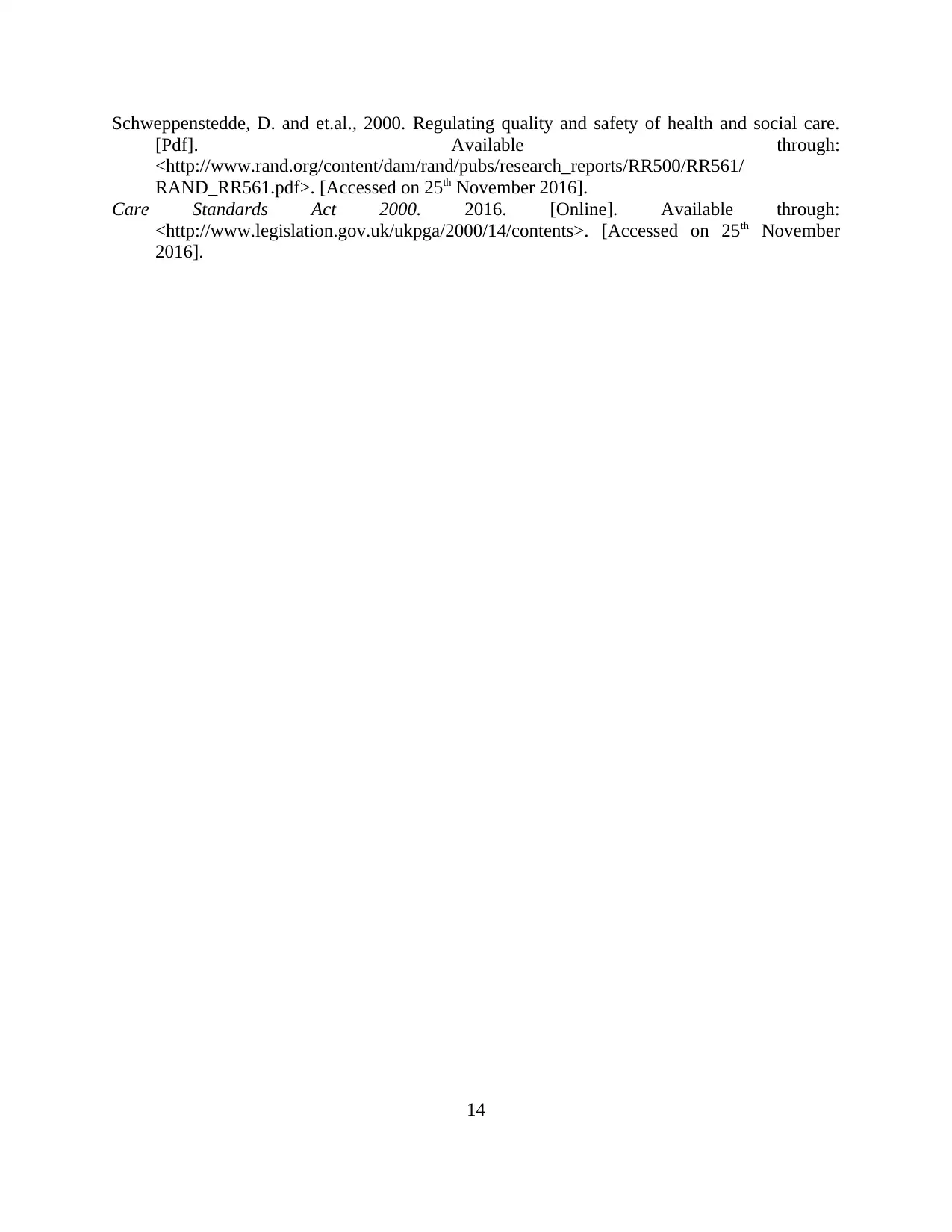
Schweppenstedde, D. and et.al., 2000. Regulating quality and safety of health and social care.
[Pdf]. Available through:
<http://www.rand.org/content/dam/rand/pubs/research_reports/RR500/RR561/
RAND_RR561.pdf>. [Accessed on 25th November 2016].
Care Standards Act 2000. 2016. [Online]. Available through:
<http://www.legislation.gov.uk/ukpga/2000/14/contents>. [Accessed on 25th November
2016].
14
[Pdf]. Available through:
<http://www.rand.org/content/dam/rand/pubs/research_reports/RR500/RR561/
RAND_RR561.pdf>. [Accessed on 25th November 2016].
Care Standards Act 2000. 2016. [Online]. Available through:
<http://www.legislation.gov.uk/ukpga/2000/14/contents>. [Accessed on 25th November
2016].
14
1 out of 14
Related Documents
Your All-in-One AI-Powered Toolkit for Academic Success.
+13062052269
info@desklib.com
Available 24*7 on WhatsApp / Email
![[object Object]](/_next/static/media/star-bottom.7253800d.svg)
Unlock your academic potential
© 2024 | Zucol Services PVT LTD | All rights reserved.





